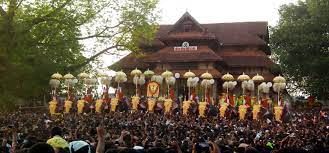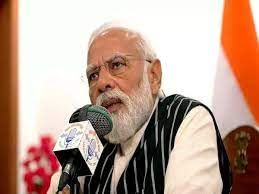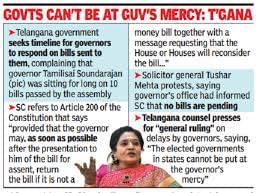UPSC Daily Current Affairs - 2nd May 2023 | Current Affairs & Hindu Analysis: Daily, Weekly & Monthly PDF Download
GS-I
Thrissur Pooram

Why in News?
Kerala is going to celebrate a 36 hours long festival which is known as Thrissur Pooram.
More about the festival Thrissur Pooram
- About:
- Thrissur Pooram is celebrated in the Malayalam month of Medam (April-May).
- This festival is considered the “mother of all poorams”.
- It is held in the Thekkinkadu Maidanam in Thrissur
- Festival highlights:
- It is confined to the temples of Devis and Sasthas.
- Thiruvambadi and Paramekkavu Devaswoms are the main participants of the Pooram.
- The festival signifies the symbolic meeting of 10 temples.
- The processions carrying the idols of participating temples — Kanimangalam Sastha, Naithalakkavu Bhagavathy, Lalur Bhagavathy, Ayyantole Bhagavathy, Panamukkampally Sastha, Choorakkottukavu Bhagavathy, Chembukkavu Karthyayani and Karumukku Bhagavathy – left for Sree Vadakkunnathan Temple in the morning.
- Arrival of the Kanimangalam Sastha marks the beginning of Pooram rituals in the morning, followed by procession from other participating temples.
- Presence of popular elephants Thechikkottukavu Ramachandran and Pambadi Rajan added to the grandeur of the cheru poorams this time.
- It is confined to the temples of Devis and Sasthas.
History
- Thrissur Pooram is an important temple festival in Kerala that dates back over 200 years.
- The festival was founded by Shakthan Thampuran, the ruler of the Kingdom of Cochin from 1790 to 1805.
- The story behind the festival goes back to the year 1796 when a group of temples were banned from attending the popular Arattupuzha Pooram due to heavy rains.
- Upon hearing their complaints, Shakthan Thampuran decided to start his own festival, Thrissur Pooram, on the same day in May.
- The festival has since become a significant cultural and spiritual event in Kerala, attracting both domestic and international tourists.
- Today, it is one of the most famous temple festivals in the world.
Celebrations
- Obeisance to the Shiva:
- The Pooram is centered on the Vadakkunnathan Temple, with all these temples sending their processions to pay obeisance to the Shiva, the presiding deity.
- The Thampuran is believed to have chalked out the program and the main events of the Thrissur Pooram festival.
- Flag Hoisting:
- The pooram officially begins from the event of flag hoisting.
- The flag hosting ceremony (Kodiyettam) begins seven days before Thrissur Pooram.
- All the participating temples of Thrissur Pooram are present for the ceremony, and there is a light fireworks to announce the commencement of the festival.
- Poora Vilambharam:
- Poora Vilambaram is a custom where the elephant pushes open the south entrance gate of the Vadakkunnathan Temple, which hosts the Thrissur Pooram, with the idol of 'Neithilakkavilamma' atop it.
- Madathil varavu:
- One of the major events in Thrissur Pooram is "Madathil varavu", a panchavadhyam melam, involving more than 200 artists, with instruments such as thimila, madhalam, trumpet, cymbal and edakka.
- Sample Vedikettu - the fireworks show:
- On the fourth day after flag hoisting, Thiruvambady and Paramekkavu Devaswoms present a one-hour-long firework show known as the Sample Vedikettu.
Significance
- It is an impressive exhibition of cultural customs and traditions, featuring adorned elephants, colourful umbrellas, and percussion music.
- The festival is a splendid blend of Kerala's spiritual and cultural heritage.
- Thrissur Pooram is a significant festival that attracts a huge number of tourists every year and is considered one of the largest gatherings in Asia.
- It has an important place in the tourism map of India.
Source: The Hindu
What is Mpox (monkeypox)?

Why in News?
Scientists recently deciphered the structure of the protein methyltransferase from the monkeypox virus.
About Mpox (monkeypox):
- It is a viral zoonotic disease caused by the monkeypox virus.
- The first human case of mpox was recorded in 1970 in the Democratic Republic of the Congo (DRC).
- There are two known types (clades) of mpox virus — one that originated in Central Africa (Clade I) and one that originated in West Africa (Clade II).
- Symptoms: Common symptoms of mpox are a skin rash or mucosal lesions, which can last 2–4 weeks accompanied by fever, headache, muscle aches, back pain, low energy, and swollen lymph nodes.
- Transmission: Human-to-human transmission of mpox occurs through direct contact with body fluids, lesions, prolonged face-to-face contact, including sexual contact, and indirect contact with contaminated clothing or bedding.
- Treatment: There are no specific treatments for monkeypox virus infection. Early and supportive care is important to help manage symptoms and avoid further problems.
What are Zoonotic diseases?
- These are infections that are spread between people and animals.
- These infections are caused by germs, such as viruses, bacteria, parasites, and fungi.
- Some can be severe and life-threatening, such as rabies, and others may be milder and get better on their own.
Source: Newsonair
GS-II
Governor’s Power to Assent Bills
Why in News?
Recently the Supreme Court has given a reminder to Governors that the Constitution expects that a decision to return a Bill to the State Assembly for reconsideration should be made “as soon as possible”.
About the office of Governor:
- Article 153 of the Constitution provides the provision that there shall be a Governor for each State.
- This Article also provides that it is not necessary for every State to have a different Governor and thus a person can be appointed as the Governor of more than one State.
- Article 154: The Governor’s position in the State is identical to the position of the President of India and just like the President, the Governor is the Executive Head of the State.
- This authority is conferred on him under Article 154 of the Constitution which provides that the Executive power of the State is vested in the Governor.
The Constitutional power of the Governor related to State Bills:
- Article 200 of the Indian Constitution deals with the Governor’s powers in relation to assenting to legislation enacted by the State legislature and other functions of the Governor such as reserving the bill for consideration by the President.
- Article 201 relates to “Bills Reserved for Consideration”: Governors have absolute veto power, suspense veto power (except on money bills), but no pocket veto power.
- Absolute Veto: This refers to the Governor’s power to refuse to sign a bill passed by the Assembly.
- Suspensive Veto: A suspensive veto is used by the Governor when he returns a bill to the State Assembly for reconsideration.
- If the Assembly resends the bill to the Governor, with or without alteration, he must approve it without using any of his veto powers.
- The Governor may not use his suspensive veto in connection to the Money Bill
- Pocket Veto: Power of the President, in pocket veto, the bill is held pending indefinitely. He neither rejects nor sends the measure back for review.
Sending for reconsideration:
- The Governor can send the bill back to the House for reconsideration but if the bill is sent back by the House without any change, the Governor has to give his assent to that bill.
- He cannot send the bill back to the State Legislature if it is a Money Bill.
Reserving the bill for the president’s consideration:
- The Governor also has the right to reserve some bills for the consideration of the President.
- when a governor reserves bill for the president’s consideration, he is no longer involved in the bill’s enactment.
- Even if the President refers it to the Assembly for reconsideration, the Bill will still be brought before the President and not the Governor following the reconsideration.
Withhold assent:
- The Governor also has power to withhold assent to a Bill
Pending bill in the legislature:
- If any Bill is pending in the House(s), the governor can send a message to such House(s) for reminding them about the same.
Supreme Court’s Observation:
- While referring to the first proviso to Article 200 of the Constitution, the SC mandated that Governors should not delay over Bills sent to them for assent after they had been passed by Legislative Assemblies.
- They should be returned “as soon as possible” and not sit over them.
- The expression “as soon as possible” in this article has significant constitutional intent and that constitutional authorities should keep this in mind.
Recent Instances of Gubernatorial Procrastination:
- Chhattisgarh chief recently questioned the governor over the delayed assent to the state’s amended reservation bill that was passed in the Chhattisgarh assembly last year which is since waiting for the governor’s assent.
- Tamil Nadu Assembly passed a resolution urging the President of India, among other things, to fix a timeline for assent to be given to Bills passed by the Assembly.
- For instance, in the TN Governor forwarded the Bill for exemption from the National Eligibility cum Entrance Test (NEET) to the President after considerable delay.
Legal Arguments against Delaying Assent:
States’ Constitutional Obligation:
- The Governor’s inaction on bills passed by the Assembly creates a situation where the state government is unable to function in accordance with the Constitution.
- If the Governor continues to fail to act in accordance with the Constitution, the State government has a constitutional obligation to invoke Article 355 and notify the President, requesting that appropriate instructions be issued to the Governor to ensure that the process of government is conducted in accordance with the Constitution.
Role of Apex Court:
- The framers of the Constitution would never have imagined that Governors would sit on Bills indefinitely without exercising any of the options given in Article 200.
- This is a new development that needs new solutions within the framework of the Constitution.
- So, it falls to the Supreme Court to fix a reasonable time frame for Governors to take a decision on a Bill passed by the Assembly in the larger interest of federalism in the country.
Way Forward:
In order to establish cordial relations between the Governor and the state legislature, the recommendations of Sarkaria Commission, Punchi Commission and Justice V.Chelliah Commission must be implemented.
Supreme Court in the Nabam Rebia judgement (2016) ruled that the exercise of Governor’s discretion Article 163 is limited and his choice of action should not be arbitrary or fanciful. It must be a choice dictated by reason, actuated by good faith and tempered by caution – the same should be implemented in letter and spirit.
Source: The Hindu
What is Article 142 of the Indian Constitution?
Why in News?
The Supreme Court recently held its extraordinary discretion under Article 142 of the Constitution can be used to do “complete justice” for couples trapped in bitter marriages by granting them divorce by mutual consent.
About Article 142 of the Indian Constitution:
- It deals with the Supreme Court's power to exercise its jurisdiction and pass an order for doing complete justice in any cause or matter pending before it.
- It provides the apex court with a special and extraordinary power and is meant to provide justice to litigants who have suffered traversed illegality or injustice in the course of legal proceedings.
- Article 142(1) states that “The Supreme Court in the exercise of its jurisdiction may pass such decree or make such order as is necessary for doing complete justice in any cause or matter pending before it, and any decree so passed or order so made shall be enforceable throughout the territory of India in such manner as may be prescribed by or under any law made by Parliament and, until provision in that behalf is so made, in such manner as the President may by order prescribe”.
- Significant cases where Article 142 was invoked:
- Babri Masjid Case: The article was used in the Ram Janmabhoomi-Babri Masjid land dispute case and was instrumental in the handover of the disputed land to a trust to be formed by the union government.
- Bhopal Gas Tragedy: The SC invoked its plenary powers in the Union Carbide vs Union Govt case and intervened to provide compensation to victims of the deadly Bhopal Gas Tragedy.
Source: The Hindu
100 episodes of PM Modi’s Mann ki Baat

Why in News?
Mann Ki Baat, Prime Minister Narendra Modi’s popular radio programme, completed 100 episodes.
Role of Man ki Baat
- At 100th episode PM framed the radio show as a national conversation that helps connect with the people — “a matter of faith, of worship”, and a “thaal of prasad” at the feet of “Janata Janardan”.
- Radio can also reach those people who do not own a mobile device and have Internet connection.
- Recognition of important initiatives like 'Selfie with Daughter’ campaign in Haryana.
- Idea is to convey positivity and to spread optimism like during the Covid-19 pandemic and lockdowns.
- Spreading awareness about government schemes and initiatives — Azaadi ka Amrit Mahotsav, Har Ghar Tiranga, digital payments, startups and unicorns etc.
- Almost every show includes little-known information about India’s arts, craft, folk culture and heroes, etc. that inform and educate, and evoke and sustain listener interest.
Evolution of Radio
- Radio Broadcasting began in June 1923 during the British Raj with programs by the Bombay Presidency Radio Club.
- Amateur radio, also known as ham radio, is the use of the radio frequency spectrum for purposes of non-commercial exchange of messages, wireless experimentation, self-training, private recreation, radio sport, contesting, and emergency communications.
- Amateur radio is practised by more than 22,000 licensed users in India.
- Amateur radio operators played an important part in the Indian independence movement with the establishment of illegal pro-independence radio stations in the 1940s.
- Congress Radio, also known as Azad Radio, was an underground radio station that operated for about three months during the Quit India Movement of 1942.
- It was organized by Usha Mehta (1920–2000), then a 22-year student activist, with the help of amateur radio operators.
All India Radio (AIR)
- All India Radio (AIR) was established in 1936 (named as Akashvani in 1956) is the national public radio broadcaster of India and is a division of Prasar Bharati. Its headquarter is in New Delhi.
- It is the sister service of Prasar Bharati's Doordarshan, an Indian television broadcaster.
- All India Radio is the largest radio network in the world, and one of the largest broadcasting organizations in the world in terms of the number of languages broadcast and the spectrum of socio-economic and cultural diversity it serves.
- AIR motto – ‘Bahujan Hitaya: Bahujan Sukhaya’.
- AIR's home service comprises 420 stations located across the country, reaching nearly 92% of the country's area and 99.19% of the total population.
- AIR originates programming in 23 languages and 179 dialects.
Private Radio
- Private participation wasn't allowed until 1993 when the government experimented with a daily, two-hour private show slot on the FM channels in Delhi and Mumbai.
- Radio City Bangalore, which started on July 3, 2001, is India's first private FM radio station.
Community radio stations
- Community radio is a radio service offering a third model of radio broadcasting in addition to commercial and public broadcasting. Community radio is when local people produce and broadcast their own programs and participate in operating the station. It is a community space for people to meet and collaborate.
- In December 2002, the government of India approved a policy for the grant of licenses for setting up of community radio stations to well-established educational institutions including IITs/IIMs.
- Sreedher Ramamurthy is regarded as the father of community radio in India.
- Currently India has 372 Community radio stations serving Farmer, Tribal, Coastal communities, ethnic minorities and special interests.
Relevance of Radio
Pandemic and the contribution of radio
- The community radio broadcasters highlighted their best practices adopted during the pandemic through their presentations. They are reaching out to hinterland through songs, drama and discussions.
- Six community radio stations in Uttarakhand have come together to spread information related to new quarantine rules, locally available food that can be nutritious and healthy, stress-busting techniques, educational programming and entertainment.
Recent government Initiatives
- It was further announced in November 2019 that 118 new community radio stations are in the process of setting up.
- Allow companies with a net worth of Rs 1 crore — instead of Rs 1.5 crore earlier — to participate in the bidding process for category C and D cities
- Removal of the three-year lock-in for restructuring.
- Removal of 15% national cap on channel holdings.
Source: PIB
GS-III
Foreign Exchange Management Act (FEMA)
Why in News?
The Enforcement Directorate carried out searches at the three premises of Byju Raveendran under the provisions of the Foreign Exchange Management Act (FEMA).
About Foreign Exchange Management Act
- The Parliament enacted the Foreign Exchange Management Act, of 1999 to replace the Foreign Exchange Regulation Act, of 1973.
- This Act came into force on the 1st day of June 2000.
- The Central government has established the Directorate of Enforcement with the Director and other officers, for the purpose of taking up investigations of cases under the said Act.
- It has been amended from time to time according to the changing economic policies and objectives of the government.
Key Provisions
- It extends to the whole of India and also applies to all branches, offices, and agencies outside India owned or controlled by a person resident in India and also to any contravention thereunder committed outside India by any person to whom this Act applies.
- The statutory power under this Act empowers the RBI as well as the Central Government to frame and pass regulations and rules from time to time, which are consistent with the foreign trade policy of the country.
- The Act provides for a legislative and regulatory framework, for inbound and outbound investments, and facilitates trade and business opportunities between Indian and other countries.
- It lays down provisions for current account and capital account transactions.
- The RBI is the regulatory body and plays a controlling role in the management of foreign exchange.
- The Act also makes provisions for enforcement, penalties, adjudication, and appeal.
Objectives
- It has been formulated by the Central Government to consolidate and amend the law relating to foreign exchange with the objective of facilitating external trade and payments and promoting the orderly development and maintenance of the foreign exchange market in India.
Progress
- It can be said that the Central Government and the RBI have been able to fulfill the broad objectives of FEMA.
- FEMA has been a reformative legislation that has also been successful in eliminating the ills of its predecessor.
Source: The Hindu
Ratnagiri Oil Refinery
Why in News?
Hundreds of villagers continued their protest against the proposed Ratnagiri Refinery and Petrochemical Limited at Barsu.
Why is there a Protest?
- Locals vehemently opposed the project, saying the oil refinery would be detrimental for the environment of Konkan region.
- Protesters claim that once the project commences, mango orchards, cashew and other plantations in the region will be destroyed within months due to chemicals.
- They demanded that the State government stop soil survey of the proposed site.
About Ratnagiri Oil Refinery Project
- The Ratnagiri Oil Refinery Project was mooted by the Centre and the Maharashtra government in 2014.
- The project was originally supposed to come up on around 16,000 acres of land, spread across 17 villages in the adjoining districts of Ratnagiri and Sindhudurg in the Konkan region. The main oil refinery was to be set up in Nanar village, which falls in the Ratnagiri district.
- It was aimed at bringing development to the backward Konkan region and would generate employment for at least one lakh local residents and also create new job generating avenues by setting up ancillary units.
- Upon completion, the project is expected to bring some stability to the oil industry in the region enabling Saudi Aramco and ADNOC to provide a steady supply of fuel to India.
Konkan Region
- The Konkan extends throughout the western coasts of Maharashtra, Goa and Karnataka.
- It is bounded by the Western Ghats mountain range (also known as Sahyadri) in the east, the Arabian Sea in the west, the Daman Ganga River in the north and the River Aghanashini in the south.
- The Gangavalli flows in the district of Uttara Kannada in present-day Karnataka. Its northern bank constitutes the southernmost portion of Konkan.
Source: The Hindu
|
38 videos|5283 docs|1116 tests
|

























